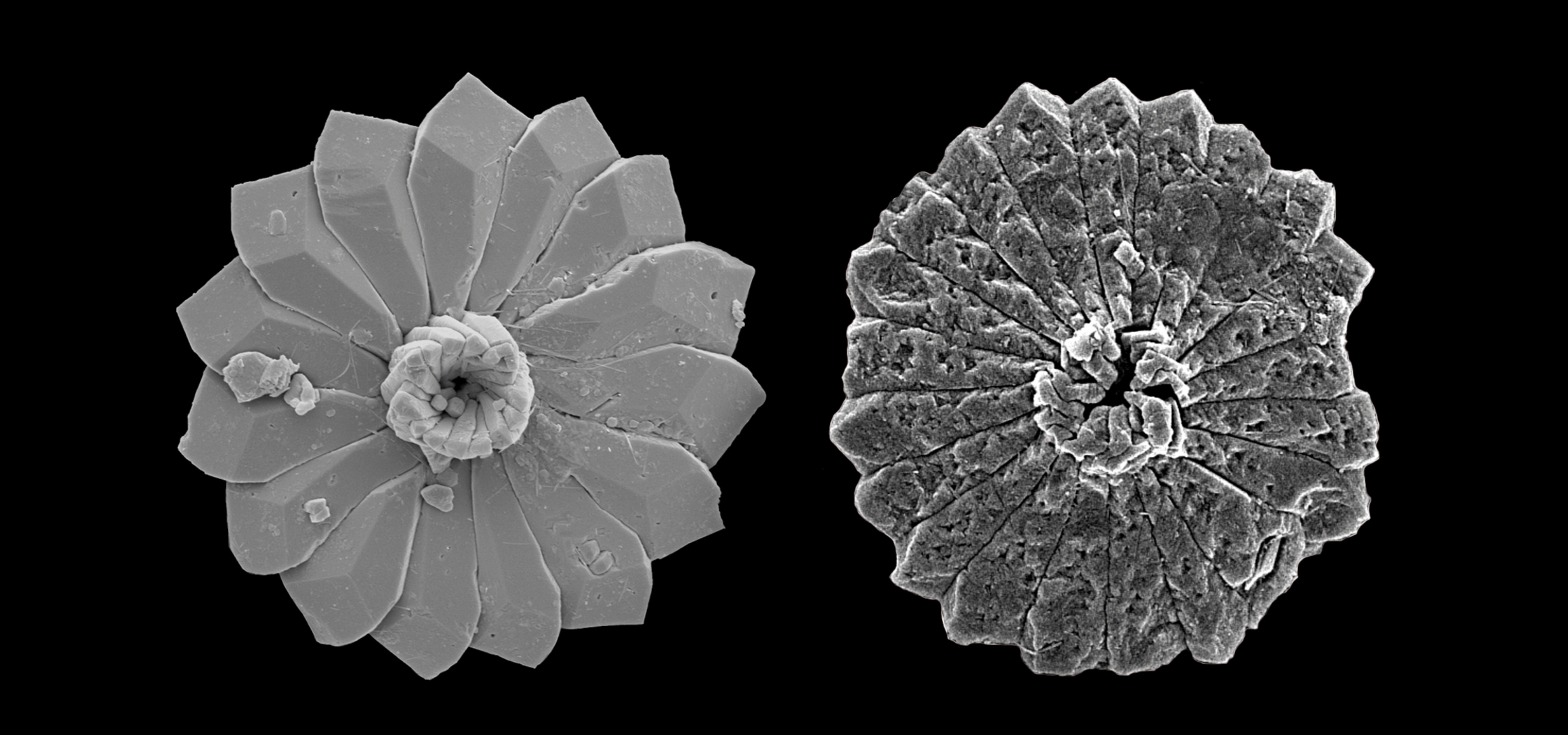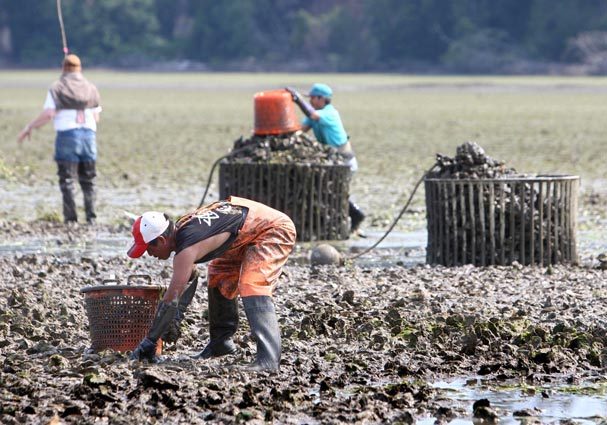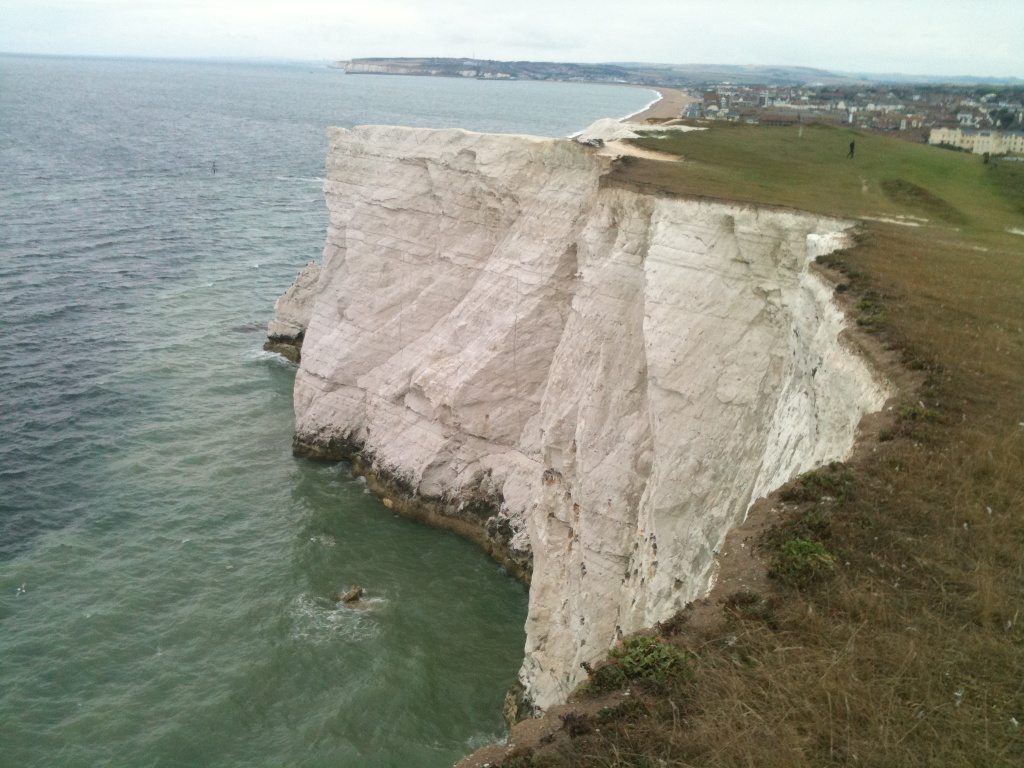Corrosive Seawater, Not Low pH, Implicated As Cause of Oyster Deaths
Posted on 12 January 2015 by Rob Painting
- Because of the geologically-rapid emission of carbon dioxide into the atmosphere by human industrial activities, and the subsequent dissolution of this CO2 into the global oceans, ocean pH and carbonate saturation state are currently declining in tandem - a process known as ocean acidification.
- Over geological timescales, however, ocean pH and carbonate saturation (corrosiveness) tend to become disassociated. This explains why the ancient oceans were highly saturated with carbonates and therefore conducive to calcification (calcium carbonate shell formation) at times of high CO2 in Earth's past even though ocean pH was lower than it is today.
- Waldbusser et al (2014) conducted a series of experiments with oyster and mussel juvenile life stages (larvae) which enable them to distinguish between the individual responses to carbonate saturation and ocean pH, something not done in typical ocean acidification laboratory experiments
- The authors surprisingly found that, except at extremely low concentrations, ocean pH by itself had little impact on larvae growth. As expected though, low carbonate saturation was very detrimental to larvae growth and thus survival. This work implicates carbonate undersaturation as the key mechanism responsible for the large-scale die-off of oyster larvae along the North American Pacific coastline over the last decade.

Figure 1 - Images of the ancient fossil calcifier Discoaster before (left) and during (right) the Paleocene-Eocene Thermal Maximum (PETM) about 56 million years ago. Both creatures lived at times when the atmospheric concentration of CO2 was much higher than present-day and ocean pH was lower, but the fossil in the right-hand image lived when carbonate ion abundance (and carbonate saturation) was also low. This was due to a rapid increase in atmospheric CO2, which caused seawater to become corrosive to calcium carbonate forms. Image courtesy of Professor Patrizia Ziveri.
Who, or What, Killed All The Oysters?
Up and down the North American coastline a non-native oyster species, the Pacific (or Japanese) oyster, is farmed commercially. The oyster is typically grown in hatcheries, which house holding tanks that take in seawater from the nearby ocean, and are fed a algal brew to stimulate growth. The juvenile oyster is shipped to farmers and, when they reach an immature development stage, the oysters are loaded into barges and then ladled out on mud/sandbanks in the natural environment. From there they grow to maturity and are then harvested.
Around 2006 many of the hatcheries began to experience a large-scale die-off of oyster larvae. At first it was suspected disease may have been responsible, as oyster are particularly vulnerable to a form of herpes virus. However this is typically associated with seawater that is warmer-than-normal and anomalous warming of local waters had not been observed. Scientific help was enlisted and it was eventually determined that ocean acidification was killing off the larval oysters, and that mortality ensued some time after low pH, low carbonate saturated, seawater was taken in from the ocean (Barton [2012]).
Local seawater pH can undergo large fluctuations, in this area primarily due to variations in the strength of the dominant northerly wind, and oyster hatcheries therefore adopted practices to nullify the impact of these fluctuations. Once the intake of seawater into hatcheries at times of naturally low pH/low carbonate saturation was eliminated, the larval oyster populations began to rebound. Ongoing ocean acidification is still a major problem for oyster hatcheries but at least, by acting on the scientific research findings, hatcheries and local oyster farmers are currently still able to make a living out of it. This may not be the case in the future.

Figure 2 - Traditional harvesting of farmed oysters at Willipa Bay, Washington, USA. Image from the Seattle Times.
It's Not all About that Acid/Base
As carbon dioxide today dissolves into seawater a number of chemical reactions take place. Some of the CO2 remains in an dissolved form (less than 1%), an amount (less than 1%) reacts to form carbonic acid, the concentration of hydrogen (hydronium) ions in seawater increases (lowering pH), and the abundance of carbonate ions decreases as they react with some of the extra hydronium ions to form bicarbonate. This last reaction also lowers the carbonate saturation state (Royal Society Report [2005]). These changes in ocean chemistry represents a challenge to marine life as maintenance of internal biological processes, such as acid/base balance, at juvenile life stages can be highly dependent on the state of the surrounding seawater and some of these processes are critical to growth and survival.
While internal acid/base regulation is highly important, of equal concern for calcifying marine life (creatures that form calcium carbonate-based shells or skeletons) is the decline in the abundance of carbonate ions as these are one of the 'building blocks' of the calcification process. A reduction in carbonate ions increases the amount of energy the calcifier has to expend in biological control of calcium carbonate formation and, in worst case scenarios, when carbonate ion abundance drops too low (undersaturation), the carbonate shell can begin to dissolve. In other words, seawater can become physically corrosive to calcium carbonate-forming marine life when a point of carbonate undersaturation is reached.
Because the dissolution of carbon dioxide into seawater is simulated by bubbling CO2 into aquariums in most laboratory experiments, these experiments make it impossible to disentangle the underlying mechanisms through which ocean acidification is affecting marine life. The reason for this is that bubbling CO2 into seawater results in simultaneous changes in the partial pressure of CO2, pH and saturation state. Now it is true that this is largely irrelevant for modern-day ocean acidification, as these older experiments are simply replicating what's occurring in the real world, but the tailored experiments by Waldbusser et al (2014) not only help to pinpoint the specific mechanisms, they also shed light on ocean acidification events that occurred naturally in Earth's ancient history. If sensitivity to carbonate saturation state is the key determinant of marine calcifier survival, as the paleo record and ocean carbonate chemistry suggest, the Waldbusser experiments should bear this out.
An Ocean Acidification Howdunnit
In order to find out what mechanism is behind the vulnerability of Pacific oysters and Mediterranean mussels to ocean acidification, Waldbusser (2014) specifically designed a set of experiments to differentiate between the various changes in chemistry that take place when CO2 dissolves into seawater. With this design the authors were able to evaluate the separate responses to CO2 partial pressure, pH and carbonate (aragonite in this case) saturation state. Of particular interest is the initial shell formation process within two days after the hatching stage, as the larvae have no swimming appendages with which to aid in feeding themselves and must therefore rely upon maternal reserves from the embryonic (egg) stage. An additional vulnerability is that the calcification process in the larvae is more exposed to the surrounding seawater at this early developmental phase, whereas calcification in later life stages occurs in internal compartments semi-sealed off from the ambient seawater. This initial shell formation stage therefore represents a 'bottleneck' in the life cycle of Pacific oysters and Mediterranean mussels - a time of great vulnerability.
Waldbusser's experiments found that carbonate saturation state was indeed the key determinant in the successful growth and development of oyster and mussel larvae in the vital early stage development of the shell. Quite surprisingly, given the importance of internal acid-base regulation, neither low pH nor the partial pressure of CO2 (i.e. an internal build-up of dissolved CO2 in the larval tissue) seemed to impart any substantially negative impacts except at extreme concentrations - indicating some limited capacity to counter internal acid build-up. On the other hand, carbonate saturation state exhibited a strong, statistically significant, relationship with shell formation and growth. See Figure 3.

Figure 3 - experimental results showing the proportion of normal shell development for Mediterranean mussel (c) & (e) and Pacific oyster larvae (d) & (f). Response to pH in (c) & (d) and aragonite saturation state (e) & (f). Note that in the Pacific oyster especially (d), even mid low saturation states (coloured boxes & circles) can prevent shell malformation at low pH. Image adapted from Waldbusser (2014).
A Window into a Corrosive Future
The North American Pacific Coast provides a glimpse into the future as these waters are naturally more acidified, and thus corrosive, than most coastal waters. The coast is on the eastern boundary of the vast North Pacific subtropical gyre, where the horizontal rotation of the gyre moves surface waters southward toward the equator. Variation in northerly wind strength speeds up, or down, the surface currents which flow away from the coast. As the surface water is displaced, this draws up cold, highly acidified, water from the deep in a process known as Ekman pumping (Ekman [1905]). Given that this deep water was last at the surface decades ago (Feely [2008]), and that atmospheric concentrations of CO2 have increased considerably since that time, the upwelled seawater in this area will only grow more corrosive in time.
Now it is expected that the upwelling will temporarily diminish when the Interdecadal Pacific Oscillation (IPO) moves into its positive (warm) phase, as a spin-down of the North Pacific subtropical gyre will weaken the northerly winds and surface currents which force the upwelling. But this temporary respite from strong corrosive seawater upwelling is only likely to raise the potential of the herpes virus as a detriment to local oyster stocks as the local seawater undergoes anomalous warming. Hopefully this doesn't happen, but the risk is there.
Corrosive Seawater Responsible For Oyster Die-off
The experiments by Waldbusser (2014) not only identify carbonate saturation (corrosiveness) as the mechanism responsible for the substantial larval oyster mortality over the last decade, but they also support observations from Earth's ancient past. It is the corrosiveness associated with low carbonate ion abundance and thus carbonate saturation state that impedes calcification, not low ocean pH. This may be irrelevant within the context of present-day ocean acidification as ocean pH and carbonate saturation decline simultaneously with the dissolution of fossil fuel carbon dioxide into the global oceans, but it strengthens the scientific case for the disassociation of ocean pH and saturation state over geologic periods of time. Ancient calcifying marine life prospered when atmospheric CO2 was high, ocean pH low, and saturation state high because seawater was not corrosive. In contrast, marine calcifiers suffered crises and extinctions (such as the PETM) when atmospheric CO2 rose sharply because ocean pH and carbonate saturation state dropped simultaneously - causing seawater to become corrosive.

Figure 4 - The White Cliffs of Dover in England are formed from massive deposits of calcium carbonate-based coccolith shells dating from the Cretaceous Period, a time of high atmospheric CO2. Over geologic timescales a huge increase in carbonate minerals were flushed into the ocean, causing pH and saturation state to diverge. The much higher than modern-day saturation state made that ancient seawater very hospitable to marine calcifiers despite the low pH. Image source unknown.































 Arguments
Arguments






























I don't think the headline here helps. The sea-water isn't corrosive, it just has reduced carbonate, which makes it harder to gain and hold solid CaCO3. But the paper seems to attack strawmen. I don't think anyone thought pH or CO2 were the direct agents. But in normal seawater, both are directly linked to carbonate. There are just two dof in the equilibrium. One thing that remains fixed as CO2 is added is total alkalinity, and so adding CO2 necessarily reduces pH and CO2.
You might be able to separate the link by varying TA artificially, but I can't see the point.
There is a gadget to demonstrate the linkage here.
(Rob P) - As the Barton et al (2012) paper linked to in the blog post states:
"We report results from an oyster hatchery on the Oregon coast, where intake waters experienced variable carbonate chemistry (aragonite saturation state , 0.8 to . 3.2; pH , 7.6 to . 8.2) in the early summer of 2009."
So the hatcheries were, at times, taking in seawater that was undersaturated with respect to aragonite and therefore physically corrosive to the larval oyster. The changing seawater chemistry would likely have had detrimental effects on the oyster larvae well before the water became corrosive to them.
I don't understand your claim about the paper attacking strawmen. The only way to disentangle the physical mechanisms through which marine calcification is affected by ocean acidification is to conduct experiments to elucidate these details. Relying on general, untested, assumptions isn't science.
I see I didn't use the right method for links. The acidification calculator is here
Rob,
In your moderator response to Stephen Baines and Doug Mackie (#37) on the recent pHraud thread, you wrote a comment (dated 11th Jan) stating that
" ... you (and Stephen) make a good point that either manner of calcification is impeded by the decline in carbonate ion abundance. Still, it gives me a opportunity to write about coral calcification & OA."
So the obvious question is "what the hell took you so long?" ;)
More seriously, in your "before and after" photo in Fig 1, would I be correct in thinking that the "after" exhibit is possessed of the characteristic reduced C13 ratio associated with a biogenic carbon burp?
Cheers Bill F